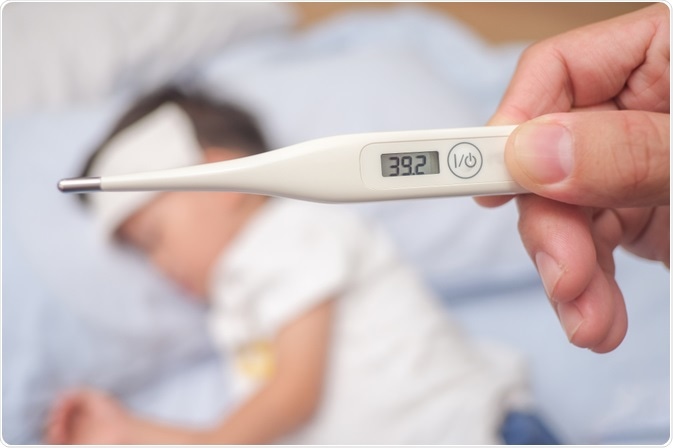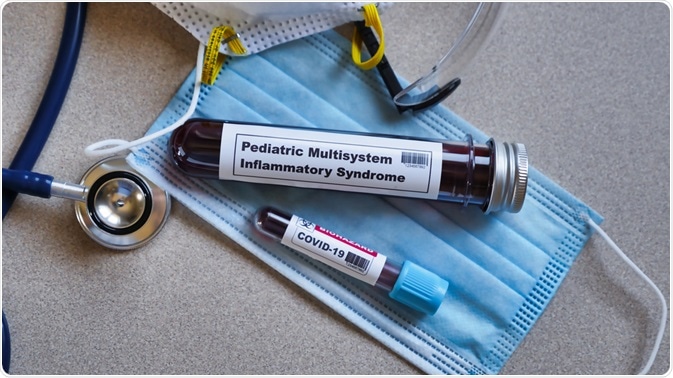COVID-19 is an infectious disease caused by the SARS-CoV-2 virus. The main symptoms of COVID-19 resemble that of a respiratory ‘flu-like’ disease, though symptoms vary considerably between affected individuals.
.jpg)
Image Credit: iunewind/Shutterstock.com
What is COVID-19?
Coronavirus Disease 2019, or COVID-19, is an infectious acute respiratory disease caused by the severe acute respiratory syndrome coronavirus 2 (SARS-CoV-2). Initially identified in Wuhan, China, COVID-19 rapidly became a global pandemic as of 30th January 2020 and is still ongoing.
Worldwide, around 8 million cases of COVID-19 have been confirmed with around 450,000 deaths (as of June 2020).
Main symptoms of COVID-19*
According to the World Health Organization, the 3 main symptoms of COVID-19 are:
- Fever - a high temperature >37.8OC/100OF
- Tiredness
- Dry cough
Less common symptoms include:
- Headache
- Diarrhea
- Loss of taste or smell
- Sore throat
- Discoloration of toes or fingers, or rashes on the skin
- Aches and pains
- Conjunctivitis
Serious symptoms are:
- Shortness of breath or difficulty breathing
- Chest pain or pressure
- Loss of movement or speech
The WHO recommends that those with serious symptoms seek medical attention immediately, calling before visiting any health facilities. If symptoms are mild and an individual is otherwise healthy, the individual should isolate and manage their symptoms without medical aid.
According to the Center for Disease Control and Prevention (CDC), the symptoms of COVID-19 are:
- Cough
- Fever or chills
- Difficulty breathing or shortness of breath
- Body or muscle aches
- Sore throat
- Headache
- Fatigue
- New loss of taste or smell
- Vomiting or nausea
- Diarrhea
- Congestion or runny nose
Affected individuals have displayed various combinations, or even just one, of these symptoms. A significant proportion will experience no symptoms at all.
Many of these symptoms are also the same for influenza (flu) and cold. However, flu symptoms usually begin abruptly within 1-4 days whereas COVID-19 symptoms may occur 2-14 days post-exposure to the virus. On average, symptoms appear after 5-6 days.
Symptoms such as a runny or congested nose, in addition to body aches and pains, are more common in flu than in COVID-19.
The symptoms of COVID-19 typically appear within 14 days of virus exposure, and this is the basis of self-isolation, or quarantine, as imposed by many nations to combat local epidemics.
Although for the vast majority of people, symptoms disappear within 14 days, there may be some cases where symptoms do not disappear and worsen that may require hospitalization.
*Note – as the COVID-19 pandemic is still ongoing, symptoms may change. This information follows advice from WHO and CDC as of 18 February 2021.

Image Credit: Yaoinlove/Shutterstock.com
Symptom severity
In a majority of affected individuals (~80-81%*), COVID-19 infection may be asymptomatic (no obvious symptoms), involve very mild symptoms (barely noticeable) or involve mild-moderate symptoms (noticeable and somewhat affects daily living, but manageable).
In a smaller proportion of affected individuals, more serious and severe symptoms may occur (moderate pneumonia). Typically, these occur in older patients (over 70) and those with pre-existing chronic health conditions.
Severe disease is thought to occur in around 14%* of patients and can result in severe pneumonia, dyspnea (severe shortness of breath), tachypnea (less than 30 breaths/min), and blood oxygen saturation (SpO2) <93% on air.
This requires hospitalization, and many patients will successfully recover, with only a small minority succumbing to their condition. The case-fatality rate (CFR) for COVID-19 is thought to be around 2.2%* on average across the globe, though this has changed throughout the pandemic and regional estimates vary.
Critical disease occurs in around 5%* of all cases resulting in acute respiratory distress syndrome (ARDS) characterized by respiratory failure, septic shock, multiple organ dysfunction and/or failure.
However, the severe and critical cases account for only a small minority of all cases, and typically in those over 70 years of age, and those with pre-existing chronic cardiovascular and respiratory health conditions.
The most common health conditions that lead to more pronounced symptoms include hypertension, diabetes mellitus, coronary heart disease, liver disease, cerebrovascular disease, COPD, cancer, renal (kidney) disease, and immunodeficiency.
Furthermore, males are affected more than females, as well as Black and South Asian ethnic minorities. Vitamin D deficiency may also be a critical factor in determining symptom (disease) severity.
It is important to note, however, some (small percentage of) younger healthier individuals may also display more severe symptoms and require hospitalization, despite no underlying conditions. Having a health condition is not necessarily a prerequisite for more severe symptoms as many with health conditions that have COVID-19 only display mild symptoms.
As of February 2021, there are many variants of coronavirus, some of which are causing significant concern. Symptoms are thought to be the same as the original strains of the disease, however, there is some suggestion that severity may not be. Data on these variants and severity of symptoms is not yet conclusive.
* CDC guidance on caring for COVID-19 patients states these percentages derived from a study on over 44,000 people in China, February 2020. Statistics are aimed to be guidance and have likely fluctuated since then.
Multisystem inflammatory syndrome in children (MIS-C)
Multisystem inflammatory syndrome in children (MIS-C) is also known as pediatric inflammatory multisystem syndrome temporally associated with SARS-CoV-2 (PIMS-TS).
MIS-C is a new disease associated with SARS-CoV-2 that has similar features to Kawasaki disease and toxic shock syndrome. Whilst COVID-19 is typically mild & benign in children with extremely limited fatalities, cases of MIS-C have been appearing in a small number of children aged 0-21 (most commonly 6-12).
MIS-C is a rare inflammatory condition seeming to be linked to the virus, usually appearing 2-4 weeks after COVID-19 infection. It is thought that a delayed overactive immune response to COVID-19 could be leading to MIS-C.
MIS-C can be treated, but it is important to catch it as the inflammation can lead to tissue damage and organ failure if left untreated. MIS-C leads to a persisting fever and a range of other symptoms including:
- Abdominal pain
- Fever
- Diarrhea
- Vomiting
- Rash
- Neck pain
- Feeling extra tired
- Bloodshot eyes
Whether COVID-19 directly causes MIS-C or not is still unclear, however in most of the recognized outbreaks, children had evidence of current or past COVID-19 infection. Research into MIS-C is ongoing.
More information can be found about MIS-C here.
Summary
In summary, the symptoms of COVID-19 resemble that of a respiratory ‘flu’-like disease with the main symptoms being fever, new continuous cough, and the loss of smell/taste, in addition to some degree of difficulty breathing and fatigue. Symptoms can vary considerably in strength – from totally asymptomatic through to critical respiratory distress.
In the majority of cases, symptoms tend to be mild or moderate at worst. Those that develop more severe symptoms tend to be older and have pre-existing chronic health conditions.
In addition, in some young children, an inflammatory Kawasaki disease-like syndrome (MIS-C) can develop that requires medical attention.

Image Credit: Bernard Chantal/Shutterstock.com
References
- Cascella et al, 2020. Features, Evaluation, and Treatment Coronavirus (COVID-19). StatPearls [Internet]. Treasure Island (FL): StatPearls Publishing. https://www.ncbi.nlm.nih.gov/books/NBK554776/
- Centers for Disease Control and Prevention. 2020. Symptoms of coronavirus. Centers for Disease Control and Prevention [Accessed 18 February 2021]. Available from: https://www.cdc.gov/coronavirus/2019-ncov/symptoms-testing/symptoms.html
- Godfred-Cato et al., 2020. COVID-19–Associated Multisystem Inflammatory Syndrome in Children — United States, March–July 2020. CDC MMWR Morb Mortal Wkly, 69:1074–1080. http://dx.doi.org/10.15585/mmwr.mm6932e2
- Lovato et al, 2020. Clinical Presentation of COVID-19: A Systematic Review Focusing on Upper Airway Symptoms. Ear Nose Throat J. https://doi.org/10.1177%2F0145561320920762 https://pubmed.ncbi.nlm.nih.gov/32283980/
- Li et al, 2020. COVID‐19 patients' clinical characteristics, discharge rate, and fatality rate of meta‐analysis. J Med Virol. 10.1002/jmv.25757 https://pubmed.ncbi.nlm.nih.gov/32162702/
- NHS. 2020. Coronavirus (COVID-19) – Main Symptoms. NHS. https://www.nhs.uk/conditions/coronavirus-covid-19/symptoms/
- NHS. 2020. Kawasaki Disease. NHS. https://www.nhs.uk/conditions/kawasaki-disease/
- Whittaker et al, 2020. Clinical Characteristics of 58 Children With a Pediatric Inflammatory Multisystem Syndrome Temporally Associated With SARS-CoV-2. JAMA, 324(3):259-269. https://jamanetwork.com/journals/jama/fullarticle/2767209
- World Health Organization. 2021. Coronavirus. World Health Organization [Accessed 18 February 2021]. Available from: https://www.who.int/health-topics/coronavirus
- Wu and McGoogan, 2020. Characteristics of and Important Lessons From the Coronavirus Disease 2019 (COVID-19) Outbreak in China: Summary of a Report of 72314 Cases From the Chinese Center for Disease Control and Prevention. JAMA. 2020 Feb 24;323(13):1239–42. doi:10.1001/jama.2020.2648
Further Reading